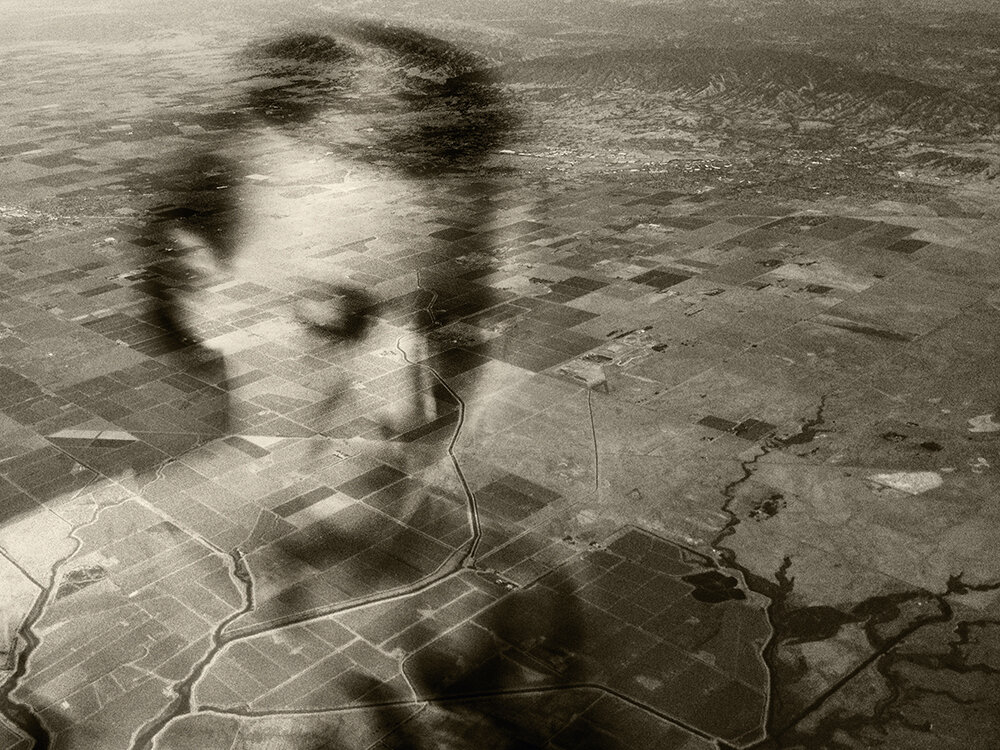Poignant Portfolio no. 19: Vaune Trachtman
Now is Always
by Vaune Trachtman
This work began one summer in the early 1930s when my father shot a few rolls of film near his father's drugstore in Philadelphia. Nearly 90 years later I was given the negatives by a relative. Working from the original negatives, I've combined the people from my father's neighborhood with my own cell phone images, many of which were shot from windows and moving vehicles.
Strand Tryptic from the "Now is Always" series
My father lived in Philly his entire life, and his images of friends and neighbors are firmly rooted in one place and time: the corner of 19th and Girard during the Depression. My images, on the other hand, are much less rooted. This is probably because I was pretty much on my own after my parents died – my father when I was five and my mother when I was 15 – and for much of my life, I was rarely in one place for very long. Often, the view out of a car or train window felt more like home than wherever I was living. Over time, I've developed a kinship with blurred bridges and highways, trestles and roofs, the husks of industrial towns racing by at two or three in the morning. In this work, my father's life becomes part of these images – our shared and evanescent homes.
Tenement Roof #1 from the "Now is Always" series
There is obviously a personal aspect to Now is Always, but I want the work to be more expansive than a dialogue between the father I didn’t know and the daughter he knew only as a child. In this work, I want to create a feeling of collapsed-yet-expanded time. Yes, I want to see what my father saw, and yes, I want him to see what I see. But I also want the viewer to look at the past, and I want the past to look right back; I want the viewer and the subject to each feel the gaze of the other. And by combining images taken almost a century apart, I also want to seamlessly integrate layers of technology and image-making history: his 1930’s point-and-shoot, my iPhone, his silver-gelatin negatives, my Photoshop files, our shared sunlight and water, and the traditions of ink, elbow grease, and an intaglio press.
Corners from the "Now is Always" series
I was born in Philadelphia. I was six when my father died and my mother maxed out her credit cards and moved me and my brother and sister to Rome, Italy, for a year. When we got back, she took a job with the Marlboro Music School, which meant we began spending our summers in Vermont. She passed on when I was fifteen, at which point family friends arranged for me to leave Philly and finish school in Vermont. After high school, I briefly attended the New School in New York, spent a semester with the Tyler School of Art Program in Rome, and then returned to Vermont as a student at Marlboro College. I then moved to Seattle, where I spent the next five years—the longest time I’d spent in one place since before my mother died.
After Seattle, I lived in Vermont for a little while, and then I moved to New York to do graduate work at NYU and the International Center of Photography. After getting my Masters, I worked for many years as an imaging specialist (photo retoucher) for Time, Sports Illustrated, Real Simple, Life Books, and many other publications. I now live in Brattleboro, Vermont.
Throughout my life, I have always taken pictures. Over time, it seemed that no matter what camera or film or printing process I used, all of my photos had the same transitory, dreamlike quality. As I’ve gotten older, I have come to realize that I have been taking pictures of the spaces between places — between here and there, between life and death, between sleep and waking. I think it is fitting that for the last few years my camera of choice has been a cell phone, a device that is in-between a telephone and a camera.
NOW IS ALWAYS will be shown at The Griffin Museum of Photography in summer 2021 and is a semi-finalist for The Print Center’s 95th ANNUAL International Competition. It is supported by a grant from the Vermont Arts Council and the National Endowment for the Arts.
Vaune was among the winners of the 2018 Alternative Processes National Competition, and she was shortlisted for the 2019 International Hariban Prize. Recent images have been shown at SE Center for Photography, Art Intersection, Photo Place Gallery, The Center for Photographic History and Technology, and Soho Photo Gallery. Keep an eye out for her work in the HBO Max reboot of Gossip Girl. She is represented by The Print Center gallery store and Zea Mays Printmaking.
From the Editor
Although Trachtman’s portfolio came to me via our website submission form she noted that folks in portfolio reviews had recommended she get in touch with us… and well, networking works! At any rate, this series is a great example of work that would have fit nicely on our previous gallery site “plates to pixels” (combining analog and digital) so it’s a pleasure to showcase it here. Trachtman has artfully combined her father’s archive of analog images with her own modern digital images and essential resurrected the past. They feel like dreams or memories… maybe collective memories, between father and kin. Or in Trachtmans’ words, they truly are the “spaces between places”. However the viewer interprets them, they honor her father’s legacy by adding her own creative vision and breathing new life into them.
–Blue Mitchell















